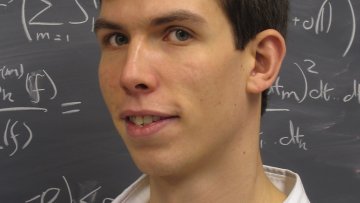An Introduction to Dixmier-Douady theory
Part of UK virtual operator algebra seminar
Abstract
A bundle of C*-algebras is a collection of algebras continuously parametrised by a topological space. There are (at least) two different definitions in operator algebras that make this intuition precise: Continuous C(X)-algebras provide a flexible analytic point of view, while locally trivial C*-algebra bundles allow a classification via homotopy theory. The section algebra of a bundle in the topological sense is a C(X)-algebra, but the converse is not true. In this talk I will compare these two notions using the classical work of Dixmier and Douady on bundles with fibres isomorphic to the compacts as a guideline. I will then explain joint work with Marius Dadarlat, in which we showed that the theorems of Dixmier and Douady can be generalized to bundles with fibers isomorphic to stabilized strongly self-absorbing C*-algebras. An important feature of the theory is the appearance of higher analogues of the Dixmier-Douady class.
Quantum Limits
Part of UK virtual operatpr algebras seminar.
Abstract
Quantum limits are objects describing the limit of quadratic quantities (Af_n,f_n) where (f_n) is a sequence of unit vectors in a Hilbert space and A ranges over an algebra of bounded operators. We will discuss the motivation underlying this notion with some important examples from quantum mechanics and from analysis.
Oxford Mathematicians James Maynard has been elected to Academia Europaea. He joins 13 other Oxford Mathematicians in the Academy which boasts 4000 members and 70 Nobel laureates.
TDA analysis of flow cytometry data in acute lymphoblastic leukaemia patients
Abstract
High dimensionality of biological data is a crucial element that is in need of different methods to unravel their complexity. The current and rich biomedical material that hospitals generate every other day related to cancer detection can benefit from these new techniques. This is the case of diseases such as Acute Lymphoblastic Leukaemia (ALL), one of the most common cancers in childhood. Its diagnosis is based on high-dimensional flow cytometry tumour data that includes immunophenotypic expressions. Not only the intensity of these markers is meaningful for clinicians, but also the shape of the points clouds generated, being then fundamental to find leukaemic clones. Thus, the mathematics of shape recognition in high dimensions can turn itself as a critical tool for this kind of data. This is why we resort to the use of tools from Topological Data Analysis such as Persistence Homology.
Given that ALL relapse incidence is of almost 20% of its patients, we provide a methodology to shed some light on the shape of flow cytometry data, for both relapsed and non-relapsed patients. This is done so by combining the strength of topological data analysis with the versatility of machine learning techniques. The results obtained show us topological differences between both patient sets, such as the amount of connected components and 1-dimensional loops. By means of the so-called persistence images, and for specially selected immunophenotypic markers, a classification of both cohorts is obtained, highlighting the need of new methods to provide better prognosis.
Topological representation learning
Abstract
Topological features as computed via persistent homology offer a non-parametric approach to robustly capture multi-scale connectivity information of complex datasets. This has started to gain attention in various machine learning applications. Conventionally, in topological data analysis, this method has been employed as an immutable feature descriptor in order to characterize topological properties of datasets. In this talk, however, I will explore how topological features can be directly integrated into deep learning architectures. This allows us to impose differentiable topological constraints for preserving the global structure of the data space when learning low-dimensional representations.


